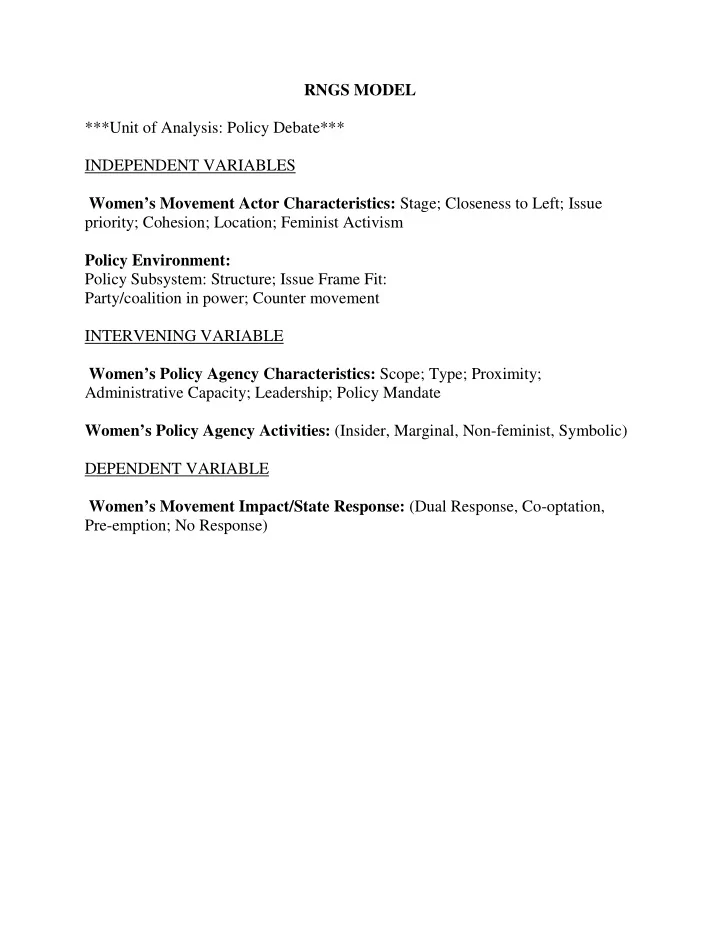

RNGS MODEL ***Unit of Analysis: Policy Debate*** INDEPENDENT VARIABLES Women’s Movement Actor Characteristics: Stage; Closeness to Left; Issue priority; Cohesion; Location; Feminist Activism Policy Environment: Policy Subsystem: Structure; Issue Frame Fit: Party/coalition in power; Counter movement INTERVENING VARIABLE Women’s Policy Agency Characteristics: Scope; Type; Proximity; Administrative Capacity; Leadership; Policy Mandate Women’s Policy Agency Activities: (Insider, Marginal, Non-feminist, Symbolic) DEPENDENT VARIABLE Women’s Movement Impact/State Response: (Dual Response, Co-optation, Pre-emption; No Response)
Typology for Women’s Policy Agency Activities _________________________________________________________________ WPA Advocates Movement Goals? YES NO WPA Genders YES Insider Nonfeminist Frame of Policy Debate? NO Marginal Symbolic __________________________________________________________________ Typology for Women’s Movement Impact/State Response __________________________________________________________________ Policy Content Coincides with Movement Goals? Women YES NO Involved YES Dual Response Cooptation In Policy Process? NO Preemption No Response __________________________________________________________________
INDEPENDENT VARIABLE INDICATORS FOR QUALITATIVE STUDY Cluster One: Characteristics of Women's Movement Actors Stage: 1. Emerging/Re-emerging. Formation of new organizations; re habilitation of older organizations toward new goals. 2.Growth: Expansion in numbers of organizations, activities. 3. Consolidation: organizations have structure, endurance and regular support; institutionalized in community and government arenas. 4. Decline/Abeyance. Decrease in organizations members and activities over the period. Latent organizational activity primarily by individuals. Closeness to Left: 1. Very Close: groups formally ally with or work with political parties and/or trade unions of the left. Ideas from the movement are taken up by left-wing parties in party platforms. Activists have internal power positions in the left-wing parties. 2. Close: groups formally ally with or work with political parties and/or trade unions of the left. They do not have internal power positions in the parties or unions and if the left takes up the ideas of movements they do so without stating so and bring these ideas to fit the party line. 3. Not Close: movement and the left are remote or hostile to each other. Priority of Issue: 1. High: issue is one of the top priorities of the women's movement activists and serves to forge alliances among the various wings and tendencies. 2. Moderate: not a uniting issue, but is a priority for some activists and organizations. 3. Low: not a priority for any organization, but mentioned by some. Not on the agenda. Not present at all on agendas of individuals and organizations in the movement. Cohesion: 1. Cohesive: movement organizations active on the issue agree on the frame and/or policy proposals. 2. Divided: movement organizations active on the issue disagree on the frame and/or policy proposals. Location : Yes or no for each dimension Autonomous Political Party Trade Union Established Interest Organizations Legislature or Government Feminist Activism: Yes or No
Cluster Two: Policy Environment Policy Subsystem Level: Structure: 1. Open: organization is amorphous, no common rules or conventions; participation is wide and changing with a variety of interest group representatives and free agents. Power balance shows no clear chain of command. 2. Moderately Closed: organization is more clearly defined but changing over time. Participation shows some regular actors but some free agents around. Power balance shows several actors trying to dominate the group but no single line of command. 3. Closed: codification of system through regular meetings and rules. Participation is limited with few free agents. Power balance shows one major actor controls policy space and parameters of the arena. A single policy community mobilizes around the issue. Issue Frame Fit: 1Policy Frame Fit: Policy Frame Fit: Policy Frame Fit: Policy Frame Fit: 1. Matching: Issue frame that initially shapes the debate is expressed in terms that are similar to movement goals as expressed by activists 2. Compatible: Issue frame that initially shapes the debate is not expressed in terms that are similar to movement goals as expressed by activists 3. Incompatible: Issue frame that initially shapes the debate is expressed in terms that are in conflict with (oppose) movement goals the debate as expressed by activists. Party or Coalition in Power 1. Strong left-wing control: left-wing parties may have majority in popularly elected legislative chambers and the Presidency/executive 2. Moderate left-wing control: left-wing parties may have the popularly elected chambers only and not the president. In the U.S. the left may have majority in only one elected chamber of the legislature. Counter-movement: 1. Strong: prevalent and proactive movement aimed at issue or issues taken-up by different parts of the women's movement. 2. Moderate: counter-movement less active against women's movement issues. 3. Weak: nearly moribund or non existent. _______________________________________________________________________
WOMEN’S POLICY AGENCY CHARACTERISTICS FOR QUALITATIVE STUDY Scope Single Issue Cross-Section Other Type Political appointments Bureaucratic Lay Panels Proximity to Power Centers Near Distant Administrative Capacity High -- Extensive staffs, separate division, field offices, subsidies, significant budget. Medium—Some staff, separate divisions, or fields offices, moderate budget. Low—Minimal staff, no separate divisions, no fields offices, minuscule budget. Leadership Feminist Not Feminist Policy Mandate Cover Debate Issue Does not Cover Debate Issue
Recommend
More recommend